Where did all the veterinarians go? Shortage across Kentucky impacts pet owners, farmers
- Oops!Something went wrong.Please try again later.
Dr. John Laster loads his truck at 5:30 a.m. on a Monday and gets on the road, driving two hours from his clinic in Todd County to see his first patients of the day.
He plans to conduct as many as 400 pregnancy exams before doling out vaccines and checking his patients' food supply, the latter of which takes a few more hours. Then, he'll get back on the road and head toward his clinic, with stops along the way to check on some of his other patients.
If he’s lucky, he’ll finish his day having served hundreds across Christian, Todd and Trigg counties by 11 p.m. and can catch a few hours of sleep before getting up Tuesday and working another 18-hour day with some of Kentucky's most important and most vulnerable patients.
"I mean, it's just my life," Laster, 36, said about his workload.
Laster is a doctor of veterinary medicine at Todd County Animal Clinic who spends about 75% of his practicing time treating large animals such as cows, hogs and other farm animals.
Laster's long hours and hundreds of patients per day aren't out of the ordinary. Most veterinarians who work full-time often end up working more than the standard 40 hours per week, including nights or weekends, and many respond to emergencies outside of scheduled work hours.
And there may be no end in sight for those exhaustive hours.
Kentucky is in the grips of a veterinarian shortage that is critically impacting farmers and pet owners and could eventually harm our food supply. The commonwealth, known for its horses, also produces the most beef east of the Mississippi River and is largely dependent on veterinarians to protect the health, safety and integrity of animals intertwined within the state's $50 billion agriculture industry.
The shortage of veterinarians is a problem across the nation, but in Kentucky, with its 13 million acres of farmland and its reputation as the Horse Capital of the World, it is compounded by an aging population of veterinarians and a shortage of veterinary medicine students filling the gaps in rural communities.
"Our farmers need access to veterinarians to protect the health of their livestock and poultry," said Ryan Quarles, Kentucky's agriculture commissioner. "Rural and food animal veterinarians are our front line of defense against disease outbreaks in our food sector."
Across the commonwealth, there are more than 2 million head of cattle, hundreds of thousands of horses, and thousands of household pets that demand the attention of the state's 2,571 active, licensed veterinarians. But as of May 2022, only 1,160 of these veterinarians were employed and working in Kentucky, according to data from the U.S. Bureau of Labor Statistics.
More: Why Kentucky's eldest veterinarians still practice amid shortage, even in their 80s
The Solution: How Kentucky is trying to solve its veterinarian shortage
In November 2022, there were only 54 veterinarians across the state who were full-time food or large animal practitioners — veterinarians who work with farm animals being raised to be food sources, according to a news release from the Kentucky Department of Agriculture.
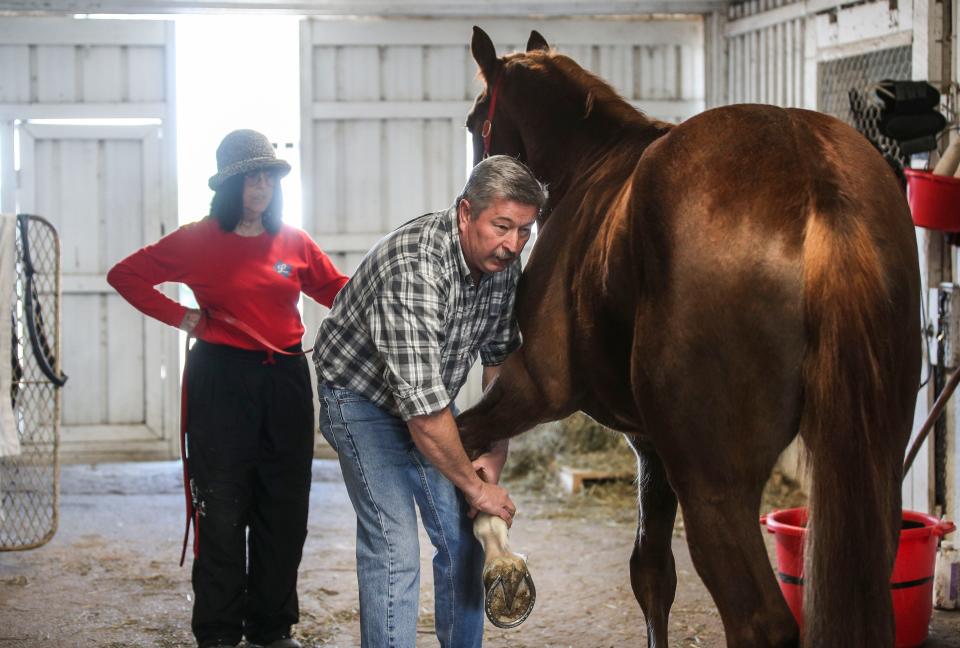
Experts like former Kentucky State Veterinarian Dr. Katie Flynn say there aren't enough practitioners to care for all the farm animals in the state, in addition to household pets.
Quarles says it's an issue that “has been going on for decades,” and as it worsens, Kentuckians from Pikeville to Paducah and every urban area in between are feeling the effects.
While those effects play out differently for farmers, the average pet owner was experiencing more difficulty getting a vet appointment, establishing a patient-client relationship for their pet, and facing longer wait times once in the door, according to a 2021 American Veterinary Medical Association study, though the AVMA said this phenomenon is "gradually returning to pre-pandemic levels."
Heavy student loan debt, increasingly long workdays, client pressures for faster and better care, and high burnout rates are key contributors to the shrinking supply of veterinarians in Kentucky and across the nation.
“It’s very dire because when somebody is trying to save their animals, it’s life and death,” said Melissa Mitchell, a farmer and veterinarian in Shelbyville.
How does the veterinarian shortage affect Kentucky agriculture?
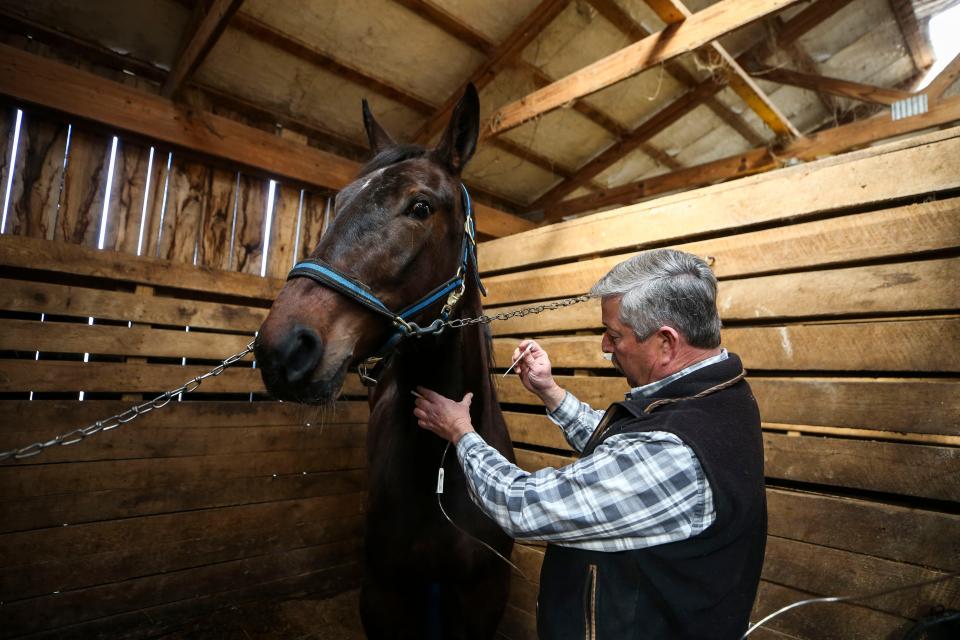
The U.S. Department of Agriculture has identified roughly 500 counties across 47 states that are experiencing a veterinarian shortage. In Kentucky, 86 of the 120 counties are currently experiencing some sort of shortage, according to the USDA.
"We have a lot of animals out there that need attention just like we do as human beings," said Quarles, the outgoing agriculture commissioner. "It's been difficult for a lot of our producers to find a large animal veterinarian because, in some areas of Kentucky, they simply don't exist, or there's very limited availability."
In 2013, when Laster began practicing, there were six large animal veterinary clinics serving Logan, Trigg, Todd and Christian counties, with 13 large animal vets, he said.
Over the next decade, the number of vets dropped drastically.
"Today, there are only seven vets covering that same geographic area," the Todd County native told The Courier Journal earlier this year. "When I say we got seven large animal vets down here in our four-county area, we're way better than most people. I mean, there's parts of the state that got one large animal vet in a four- or five-county area."
The veterinarian shortage can have myriad impacts in a state like Kentucky.
"Veterinarians are literally involved from the reproductive processes, from the day the animals are born, to the nutrition, all the way up the food chain to food supply safety inside of slaughterhouses ... they're involved in every aspect of food safety," Laster said.
Food supply and security depend on veterinarians
The lack of veterinary care impacts more than just animals on a farm and the pets in your house. It also affects food availability and safety.
“The shortage of veterinarians to treat our agricultural animals is affecting farmers and may soon begin affecting our food supply,” Quarles said in a statement in June.
At the JBS Pork Production Facility in Louisville, the proper staffing of USDA veterinarians and food safety and inspection service workers that “inspect and test livestock and animal products for major animal diseases” is crucial to maintaining a safe food supply, according to the U.S. Bureau of Labor Statistics.
At the slaughterhouse in Louisville — which is fully staffed with 12 USDA employees — as dead hogs hang from a conveyor system on their way to be cut into bacon, ribs and more, employees stand in a line, inspecting every single pig that passes, examining the pigs' organs and looking for other animal abnormalities that “make a product unfit for human consumption.”
It is only after that inspection by veterinary medicine staff that a hog is permitted to carry on through the disassembly process and eventually make its way to kitchen tables. Much of the 604 million pounds per year of pork processed in Louisville ends up on Costco shelves across the country.
"There is potential impact on our food supply," Flynn, the former state veterinarian said of a veterinary shortage. "If we don't have healthy animals, we don't have healthy animals going into our food supply."
A lack of large animal veterinarians and what that means for rural communities

Bernice Amburgey, a horse owner and volunteer with the Appalachian Horse Project, a nonprofit dedicated to Kentucky’s free-roaming horses, has felt the impact of the shortage at her homestead. She has started scheduling her horses' vet appointments "way in advance" and even learned some basic injury and wound care so she can tend to her pets if needed.
"If we would have a colic or, you know, a really bad injury, and can't get to a vet, we basically could lose our horse," she said.
Amburgey, who lives in Knott County, had one of her horses choke. Unlike humans, horses cannot throw up to release stuck objects, so when something gets lodged in a horse’s throat, while it doesn't block the airway, it creates extreme discomfort for the animal.
The closest veterinarian to Amburgey is 60 miles away in Pikeville, she said. In that instance, it took an entire day before a veterinarian was able to get to her farm.
"We used to have a local vet in Hindman, Kentucky, ... and then we had one closer in Floyd County; and she passed away ... and then there was Hazard," Amburgey said. "Over the years, they've either retired or moved away, and nobody can replace them."
Amburgey said the experience was "traumatic. ... You wait all day, and your horse is suffering ... It's heartbreaking."
And there is no immediate end to the vet shortage in sight.
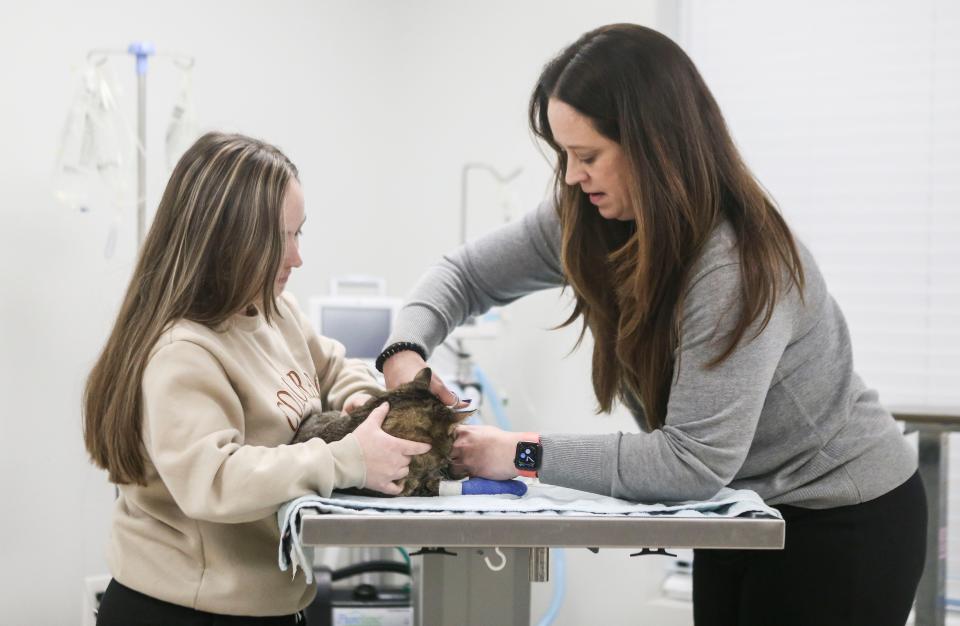
From 2013-22, there has been a nearly 23% decrease in practicing food animal veterinarians nationwide, according to data from the American Veterinary Medical Association.
Despite this reduction in vets, farming industries have continued to see increases. In 2022, the U.S. produced 1.4 billion more pounds of commercial beef cattle than it did in 2018.
This puts even more pressure on the 3,606 food animal veterinarians across the nation.
Nationwide, about 5% of all veterinarians work with farm animals. In Kentucky, only 3% of all vets across the state have a dedicated large animal practice, according to the Kentucky Department of Agriculture.
"I think one of the things we have to look at when we look at the large animal practitioners and the rural areas, is ... the salaries they're getting paid as compared to the small animal practitioners," said Flynn. "Typically, the large animal practitioner salaries are lower, they typically have a more challenging work-life balance, and they may be the only veterinarian in that area trying to cover a lot of ground."
According to the Kentucky Department of Agriculture, the average veterinarian will graduate from college with about $200,000 in debt. The average annual wage for all veterinarians — large animal, small animal, equine, and mixed practice — in Kentucky is around $105,000.
But, in rural areas of the commonwealth, where large animal vets are more likely to work, some veterinarians are making less than $50,000 annually.
Why Kentucky has a veterinarian shortage
Nearly 40% of all large animal vets in Kentucky are within 10 years or less of retirement age, with the oldest practicing vets clocking in at 93 years old.
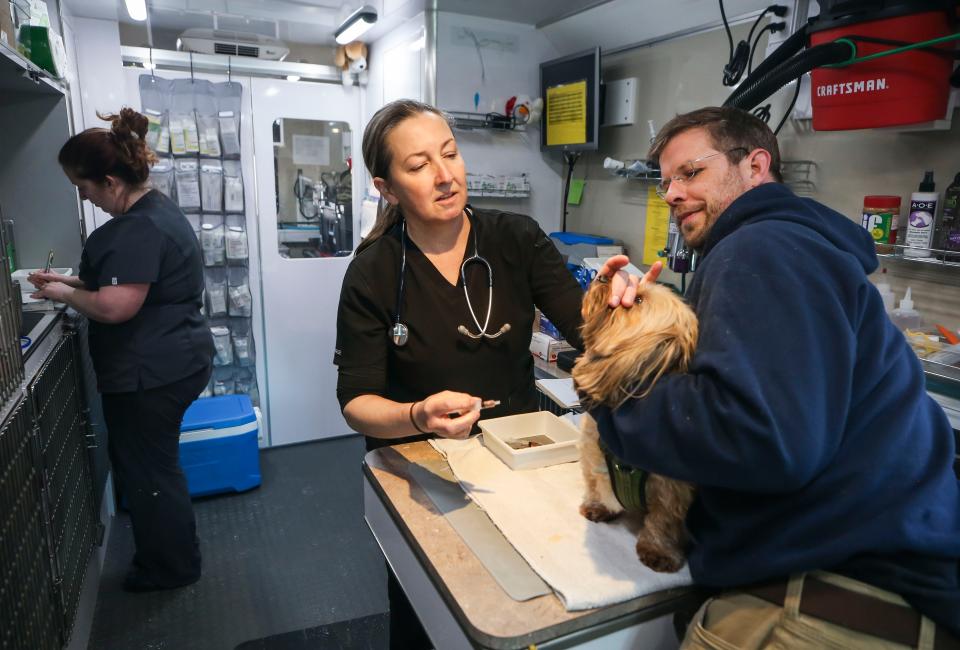
"Approximately half of Kentucky's food animal practitioners are over the age of 50 … and only 10% of graduates in the last five years dedicate more than 15% of their time to food animal medicine," Flynn wrote in an application to the USDA for resources to help with the shortage. "This data indicates that within the next 10-15 years, Kentucky's shortage of food animal practitioners is likely to significantly increase."
Salary, debt and age aren't the only factors contributing to the vet shortage. Experts say burnout is a key culprit to the shrinking field. Besides the physical demands that come with working with animals that can bite, kick or scratch, veterinarians often bear an emotional toll coming across abused animals, euthanizing a family's beloved pet, or losing a calf during birth, in addition to stress from pet owners and farmers who demand quicker, cheaper services.
The amount of stress veterinarians are facing has increased since 2019, Merck Animal Health research and consulting group reports. Nationally, as much as one-third of veterinary staff “are likely to leave” the industry in the next two years, the 2022 study showed.
This research group also found that 91% of veterinarians see the continued shortage as the most concerning part of the industry, which not only leads to burnout but in some cases, death. According to Not One More Vet, a nonprofit aimed at addressing mental wellness in the veterinary medicine field, veterinarians are nearly two times more likely to die by suicide than the general public.
"Short term, my concern is the burnout rate of veterinary support staff and veterinarians is so high and mental health issues are so high that if the demand stays the same ... you will be so overworked and so burned out that you'll be even shorter and shorter on veterinarians," said Dr. Rebecca Hite, a veterinarian and part owner of Johnson Animal Clinic in Louisville.
Another hit to rural farmers' income
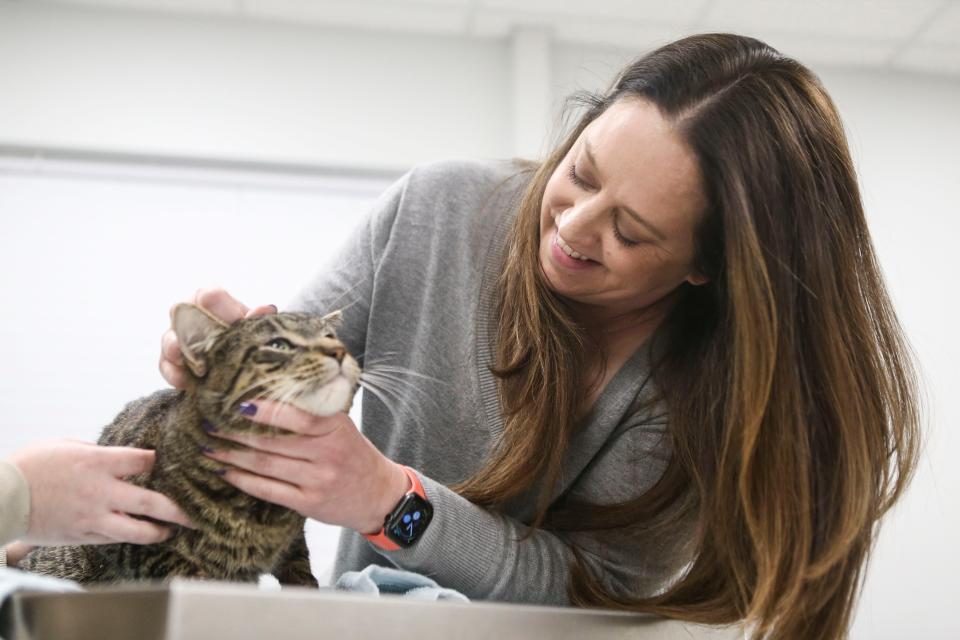
In 2017, Kentucky had roughly 1,100 fewer farms than it did in 2012, according to data from the University of Kentucky. However, the acreage of farmland across the state decreased by less than 1% in this same period.
"We have fewer farms, but the farms that are there are bigger, and ... they're further apart from each other... That makes it difficult for a veterinarian to make calls to go to the farm," said Dr. Debbie Reed, director at the Murray State University Breathitt Veterinary Center in Hopkinsville. "And [with] several calls in one day, farms are so far apart that it's hard to drive from one to the other."
With fewer veterinarians able to visit, farmers are at a higher risk of losing their livestock and income. Veterinarians, like Laster in Todd County, know in an emergency it's not only a battle of life and death but a battle of financial gain or loss.
That's why Laster has started to train farmers to respond to emergencies on their farms and keep the animals stable until a veterinarian can get there.
"[The shortage] impacts the farmer's ability to take good care of their animals; that also impacts that farmer's ability to make a good income off of the livestock they raise," Reed said.
Previously, farmers were allowed to buy some medicines, such as penicillin, at farm supply stores. But in June, regulations under the U.S. Food and Drug Administration's Center for Veterinary Medicine changed, moving many of these over-the-counter antibiotics to prescription only.
Farmers now need to consult with a veterinarian and have the prescription authorized before being able to purchase, creating yet another task for vets.
"If food animals are becoming ill, then they are not able to make it to the grocery store or to McDonald's... If animals are sick or dying, then that means less meat on the table for the consumer," Reed said. "It would mean prices increase because there's a limited amount .... and maybe even less nutritious food."
'There are animals that don't get treated'
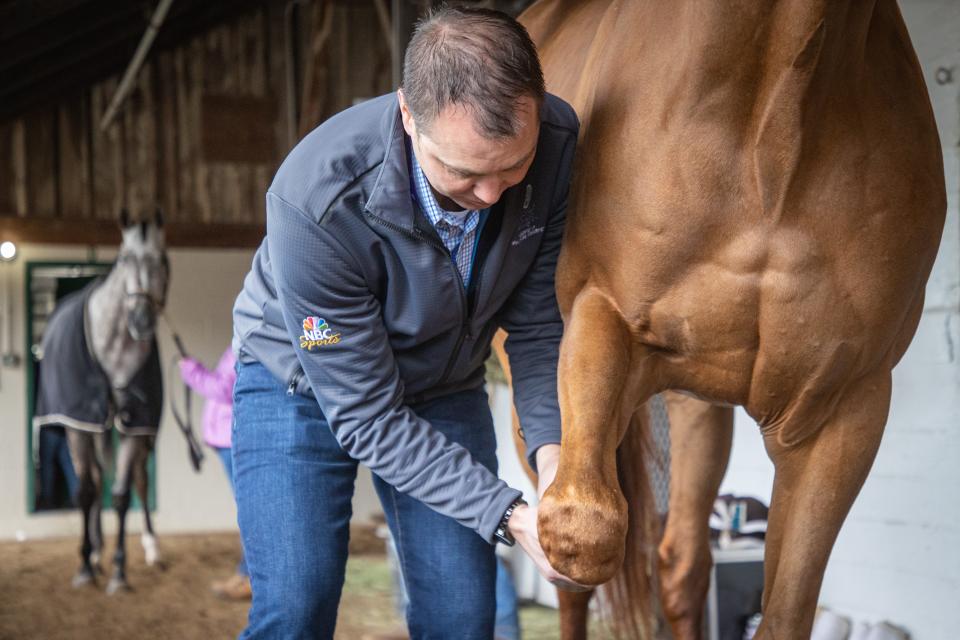
Kentucky is home to about 240,000 horses, according to the Kentucky Thoroughbred Association. All of these horses, plus the host of horses traveling in and out of Kentucky, will, at some point, interact with a veterinarian.
"We have a responsibility to take care of our animals; we have a vested interest in animal welfare, providing veterinary care for them as part of it," said Dr. Andy Roberts an equine veterinarian on the board of directors for the Kentucky Association of Equine Practitioners.
The equine industry is a $6.5 billion business in Kentucky, spanning racing and betting, competitions, tourism, labor and more.
The Kentucky Horse Racing Commission, the governing body charged with regulating and maintaining safety in horse racing across the state, has 12 veterinary services employees on staff. Racetracks like Churchill Downs in Louisville, and Keeneland in Lexington, staff their own veterinary teams, as well. This year, equine veterinarians were in the spotlight as Churchill Downs dealt with an abnormal amount of horse deaths leading up to Kentucky Derby 149.
"The veterinarians certainly aren't turning down any work," Dr. Will Farmer, equine medical director for Churchill Downs Inc., told The Courier Journal in April. "It's a struggle on a day-to-day basis for the racetracks."
Roberts, who travels around the state covering veterinary needs at smaller tracks, said during the racing season he can see as many as 75 horses a day and easily works 18 hours a day. Roberts, who is based in Lexington, said the four-hour drive to the Oak Grove racetrack in Christian County isn't ideal but must be done.
"It's not a profitable drive, four hours one way to work, and then four hours again, but you have to do it," Roberts said. "You have horses to take care of."
But not all racetracks and horse farms are created equal. Some tracks rely on traveling vets like Roberts, and horse owners at small farms often don't benefit from name recognition or in-house veterinary services.
"There are people who just simply have to wait ... and there are animals that don't get treated," Roberts said.
Contact business reporter Olivia Evans at oevans@courier-journal.com or on Twitter at @oliviamevans_.
This article originally appeared on Louisville Courier Journal: How vet shortage in Kentucky is impacting pet owners and farmers

